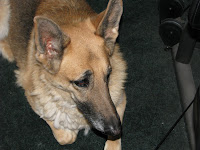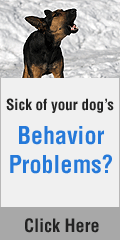A fear-bite is a bite that occurs out of sheer panic. It’s not to be confused with dominance-aggression, which is a sign of deep-set personality problems; a fear-biter isn’t necessarily a ‘fierce’ dog. He’s just scared. Why does fear-biting happen? A fear-biter bites because it’s his only way of expressing his extreme fear or panic, and his only way of telling his owner that he can’t handle the situation. Almost all cases of fear-biting are actually caused by well-meaning, but ill-advised, humans: they see what’s clearly a scared dog, and – intending to either comfort the dog or to show him that there’s ‘nothing to be afraid of’ – they approach too close, and push an already-anxious dog over the edge. Dogs can’t ask us to please leave them alone. They can’t tell us that something’s bothering them, or that they need some space: all they can do is sign the message to us through their body-language. It’s easy to tell when a dog’s feeling scared or panicky once you know what to look for. Fear-biting never just happens ‘out of the blue’: it only occurs when people ignore the signs. Fear-biting: the warning signs Fear-biters are submissive dogs. When faced with a new situation or unfamiliar people, they do not react with the customary effortless confidence of a well-socialized, well-adjusted dog: instead, they become nervy and on edge. A scared dog, when faced with the unfamiliar, will assume a distinctively submissive posture, and will display several marked behaviors. The more common of these are listed below. Posture - Tail tucked (or, if docked, the back legs will crouch down and the haunches will ‘tuck’) - Hunched, lowered back - Ears flat against the head - Elbows bent in a slight crouch Behaviors Excessive panting (hyperventilating) Yawning (an attempt to reduce tension) Avoidance of eye contact In extreme cases, a dog may also urinate or defecate out of fear What makes some dogs into fear-biters? All dogs undergo what’s called a fear-imprint stage when they’re about eight weeks old, and another one at about fourteen weeks. During this period of a dog’s formative puppyhood, he’s significantly more prone to ‘spookiness’: being excessively startled by new experiences and situations. If a dog has a scare during this time which isn’t properly dealt with by the owner (ie, after receiving a scare, he isn’t then taught not to be frightened of that thing), he may develop a life-long phobia towards that object. For example, if he’s been frightened by a repairman arriving at the door unexpectedly, and isn’t then acclimatized to that person, he may develop a long-standing phobia of men who resemble that repairman (men with beards, men in overalls, men holding toolboxes, etc). Some dogs are also just highly-strung and more prone to anxiety because of their breeding. Certain breeds – typically, the more intelligent ones, and the ones emotionally dependent on close, regular interaction with humans – have proven themselves more likely to develop phobias and excessive shyness than other, more emotionally stable breeds. A few of these ‘anxious’ breeds include Weimaraners, Great Danes, and Border Collies. A history of trauma or abuse is another major cause of fear-biting: many abandoned or abused dogs develop anxiety problems, which, without proper treatment, may progress into fear-biting. The difference between shyness and fear-biting It’s quite natural for some dogs to exhibit signs of shyness towards unfamiliar situations. It doesn’t mean that that dog is a ‘difficult dog’, or that he will grow up to be a fear-biter – some shyness is to be expected in almost all dogs at one point or another. Shyness only becomes a problem when it begins to interfere with the course of daily life: when a dog can no longer be trusted around strangers, for example, or if his behavior is endangering his own safety (scared dogs often bolt, sometimes across busy roads), or when your own life becomes significantly restricted by your dog’s fear. How to cope with fear-biting First of all, make sure your own attitude to the problem is realistic. While the behavior of a fearful dog can often be significantly ameliorated by careful training and acclimatization, on other occasions – and sometimes, despite your best efforts – a dog will remain fearful to the end of his days. You cannot force your dog to overcome his fear. Treatment requires patience, persistence, and consistency: rough treatment (anger, frustration, shouting, a take-no-prisoners approach) usually worsens the problem, because it increases the dog’s anxiety levels instead of decreasing them. You cannot train a scared dog not to bite: he’s responding to a powerful blend of instinct and sheer panic. No training in the world can counteract these two things – as motivators, they’re just too strong. What you can do is, firstly, build up your dog’s confidence, to reduce his overall anxiety and tension levels; and, secondly, pay close attention the cause of his fear, and work to desensitize him to it. Building up his confidence Obedience training is a great vehicle for doling out praise and rewards: simply dispensing treats at random won’t do any good, since the issue here is drawing attention to achievement and good behavior (your dog can tell the difference between an earned and an un-earned reward!). Start small, with basic obedience classes, and practice the commands for five to ten minutes every day. Remember to set him up for success: start off with the easy commands, and make sure he’s thoroughly comfortable with them before progressing to the next level. Always treat and praise liberally for good behavior. Desensitizing him to the fear-object Desensitizing your dog is all about slowly accustoming him to whatever it is that’s eliciting the fear response, at a pace that’s comfortable for him. The emphasis is on maintaining comfort levels: your aim here is to keep your dog happy and serene (as much as possible), so that he learns through direct experience that the cause of the fear isn’t actually scary after all. So if he’s afraid of, say, the vacuum cleaner, start integrating it into daily life. Remember to move slowly and not to push him too far, too fast: start by simply leaving it out in a prominent position, where he’ll have lots of incidental contact with it (for example, in the middle of the lounge carpet). Allow him plenty of opportunity to sniff it and walk around it, Play with him near it; feed him near it. Integrate the object or the situation (whether it’s the garbage truck, strangers approaching the door, small children, driving in the car) into normal, everyday life as much as possible. Counterconditioning Once he’s become desensitized enough to the fear-object that he’s reasonably calm around it (so, he might be exhibiting signs of fear, but isn’t panic-stricken to the point of wetting himself or hiding), you can start counterconditioning: teaching him to associate good things with the fear-object. You can do this by dispensing treats liberally, and doling out lavish praise for any improvements in his fear-levels. Do’s and Don’ts Do: Cue your dog. He takes his emotional and psychological cues from you, so make sure you’re a good role model. Adopt a straightforward, no-nonsense attitude, and stick to it. When he’s frightened, talk to him in a relaxed, don’t-be-silly manner, keeping your tone matter of fact and direct. Socialize him frequently and thoroughly. Even though the most critical socialization period is from eight to sixteen weeks, it should still be an ongoing process throughout your dog’s life. The more opportunity he has to accustom himself to the ways of the world, the easier it will be for him to see that, really, there’s not much to be scared of. Be patient and move slowly. Don’t try to rush your dog, or force him to confront objects, people, or situations that he’s scared of – you’re trying to countercondition his learned fear-reflex, and you’re not going to do that by teaching him to associate feelings of anxiety with the fear-object. Pay attention to his body language at all times. Some whining and trembling are OK, but if he’s wetting himself, hyperventilating, and showing the whites of his eyes, he probably needs some space. Even though a fear-bite isn’t inflicted out of a direct desire to cause harm, it’s still a bite, so give him what he needs! Don’t: Crowd him. Scared dogs need space, more than anything else – you won’t make things easier for him by entering his ‘personal bubble’. If he’s really scared, back off, and wait for him to approach you. If he’s hiding, or strenuously resisting your direction, pay attention to what he’s trying to tell you: that he’s not comfortable enough to proceed yet. Forcing him outside his comfort zone is when bites happen. Don’t coddle him or reward his fearful behavior with special attention. It’s great to praise, pet, and cuddle him for good behavior, increased calmness, and being brave enough to approach/sniff/explore the object of fear – it’s not good to reward him for fearful behavior. Save the special attention for when he deserves it: remember to reward the behavior you wish to see repeated; ignore the behavior you don’t. For further information For more information on problem behavior in dogs, check out SitStayFetch. It’s a comprehensive training manual for dog-owners, and covers just about everything you could ever want to know about raising a happy, healthy, well-adjusted dog: from canine psychology to dog whispering to preventing and handling problem behaviors to obedience training, SitStayFetch has it all covered. You can visit the SitStayFetch website by clicking on the link below:
Kingdom of Pets: Sit-Stay-Fetch
bittersweet
17 years ago









